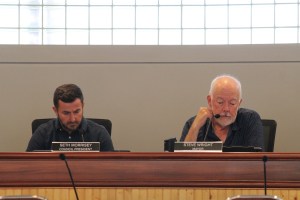Ship’s Astoria tours spearheaded by local resident
Published 5:00 pm Tuesday, May 27, 2008
Jerry Ostermiller was key in getting public access to ship during North Coast visitJerry Ostermiller has seen the USS Missouri, inside and out.
Trending
The president of the Columbia River Maritime Museum in Astoria spearheaded the drive to make the 1998 visit to the Port of Astoria a public one instead of just an environmental one.
When the USS Missouri Memorial Association took over the battleship from the U.S. Navy, it had been mothballed at the Puget Sound Naval Shipyard in Bremerton, Wash., since being decommissioned in 1992. Marine organisms had collected on its hull and they had to be removed by spending time in warmer, less salty water before heading to its final resting place in Hawaii.
When Ostermiller learned the ship was going to be berthed at Astoria for almost a week, he realized it was “a World War II icon” that many visitors – especially the “Greatest Generation” – would like to see.
Trending
He contacted Mark Hatfield, the recently retired Oregon senator who served on the board of the Maritime Museum. The mission had significance beyond mere tourism: Hatfield had been a U.S. Navy lieutenant and had led a landing craft at Okinawa. Hatfield immediately got in touch with the Secretary of the Navy and secured permission.
Ostermiller traveled to Bremerton to check over the ship and design a tour path that would be safe and allow the maximum number of visitors. He recalled climbing – alone – in the bowels of the rusting battleship, drawing on skills he had learned as part of the North Coast’s high-angle cliff rescue group.
“It was very spooky being on that ship by myself.”
When the Missouri arrived at the port, there was a welcoming ceremony followed by a deluge of visitors from all over the world. The community was swamped.
Ostermiller joined leaders of the Port of Astoria, the Astoria police and fire departments, the Clatsop County Sheriff’s Office and other agencies in a summit meeting on that first night. Together, they crafted a response plan that created new turn lanes, improved parking and developed a more orderly waiting line.
“It was logistically so challenging,” Ostermiller recalled. Because of the traffic congestion, his volunteer tour guides commuted from the museum to the battleship on small boats.
“It was extremely rewarding for all of us,” he said. “It was a struggle for everybody, but when it was over we knew we could survive anything.”
Ostermiller said the elements of cooperativeness between government agencies during last year’s December storm prompted a few leaders to mention that crisis was “just like the Missouri.”
The biggest reward of the Missouri visit, Ostermiller said, was the reaction of the visitors.
“Day after day I stood at the top of the gangwalk and there would be an 80-year-old lady who would look across the deck and say ‘Thank you for making this happen. My Johnny told me that what happened on this ship saved his life’ and they would cry and say ‘He’s been gone five years.’ That happened to me a dozen times.”
Ostermiller and his wife, Lynne, marked their 25th wedding anniversary in February with a trip to Hawaii. He enjoyed a tour of the refurbished ship, the first time he had seen it since organizing its Astoria visit in 1998.
“She looks pretty good now,” he said. “That ship really needed to have a public location like that.”









